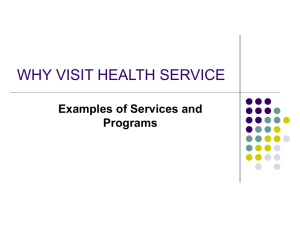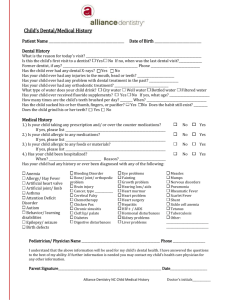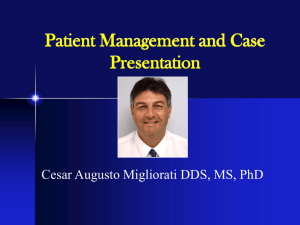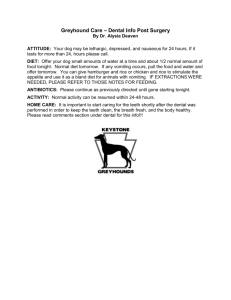Diagnosis - TARGET Center
advertisement
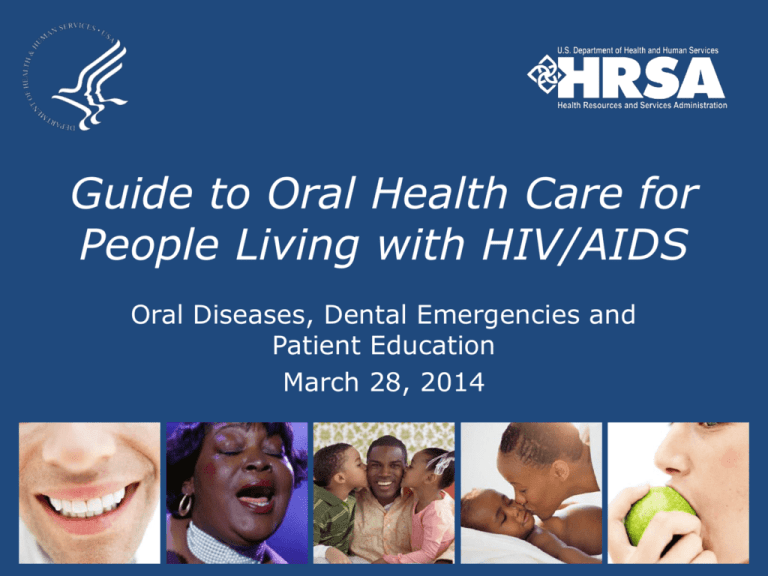
Guide to Oral Health Care for People Living with HIV/AIDS Oral Diseases, Dental Emergencies and Patient Education March 28, 2014 Introduction • HRSA/HAB sponsored curriculum designed to assist primary care providers to recognize and manage oral health and disease for people living with HIV/AIDS. • Benefits of oral health integration in primary care: – – – – Improve earlier linkage to oral health care Reduce avoidable complications including oral-systemic Reduce burden/costs of preventable diseases Improve OH literacy of health care professionals and public • Webinar series – Chapters 1-2: was conducted on March 7 – Chapters 3-5: March 28, 2-4 PM • Webcasts on TARGET Center: (https://careacttarget.org) 2 Housekeeping • Everyone is in listen only mode • Q&A will be taken during designated breaks through presentation – Questions will be handled via chat pod or operator assistance • If you are viewing the webinar in a group, please provide the total number of people viewing the webinar in the appropriate pod. 3 Guide to Oral Health Care for People Living with HIV/AIDS Chapter 3: Oral Diseases Chapter 3: • Course Authors: – Jeffery D. Hill, D.M.D. – Carol M. Stewart, D.D.S., M.S. • Consultant: – Vincent C. Marconi, M.D. • Series Editor: – David A. Reznik, D.D.S. • HRSA, HIV/AIDS Bureau Consultant: – Mahyar Mofidi, D.M.D., Ph.D. 5 Chapter 3: Learning Objectives • After viewing this presentation the learner should be able to: – 1. Be familiar with recognition and management of oral lesions commonly seen in HIV disease. – 2. Enhance ability of the medical team to recognize emergency dental needs vs. routine dental care. – 3. Discuss with patient key elements to maintain oral health. 6 Clinical Presentation • Categorizing lesions by clinical characteristics helps to focus the differential diagnosis • • • • • White lesions Red lesions Ulcerated lesions Papillary lesions Pigmented lesions 7 White Lesions Pseudomembranous candidiasis Clinical presentation Signs: -multiple white plaques -any mucosal surface -can be scraped off -red surface beneath Symptoms: -burning sensation -metallic taste Etiology Candida albicans (most common) C. glabrata Diagnosis clinical appearance cytological smear Treatment (14 days) topical anti-fungal systemic anti-fungal 8 White Lesions Oral hairy leukoplakia Clinical presentation Signs: -vertical corrugations -lateral border of tongue -usually bilateral -hairy or shaggy appearance -cannot be wiped off Symptoms: -painless Etiology Epstein-Barr virus Diagnosis clinical appearance Treatment usually none required high-dose anti-virals 9 Red Lesions Erythematous candidiasis Clinical presentation Signs: -macular, papillary atrophy -dorsal tongue, hard palate -edentulous ridge under denture or removable partial denture Symptoms: -asymptomatic or burning sensation Etiology Candida albicans (most common) C. glabrata Diagnosis clinical appearance cytological smear Treatment topical anti-fungal 10 Red Lesions Angular cheilitis Clinical presentation Signs: -labial commissure -fissured, scaley patches -unilateral or bilateral Symptoms: -pain, bleeding -burning sensation Etiology Candida albicans Contributing factors: nutritional deficiency loss of vertical dimension Diagnosis clinical appearance Treatment topical anti-fungal resolve contributing factors 11 Red Lesions Linear gingival erythema Clinical presentation Signs: -distinctive red band -free gingival margin -minimal edema Symptoms: -minimal bleeding -mild pain/tenderness Etiology unknown Diagnosis clinical appearance Treatment thorough dental cleaning chlorhexidine rinse 12 Ulcerated Lesions Aphthous ulcers Clinical presentation Signs: -non-keratinized mucosa -erythematous border -yellowish-gray pseudomembrane Symptoms: -very painful Etiology immunologic defect triggers include physical trauma and stress Diagnosis clinical presentation Treatment often heal spontaneously topical corticosteroids systemic steroids 13 Ulcerated Lesions Recurrent intraoral herpes Clinical presentation Signs: -keratinized mucosa -whitish-yellow border -red interior Symptoms: -painful Etiology HSV-1 Diagnosis clinical presentation viral culture Treatment systemic anti-virals 14 Ulcerated Lesions Herpes zoster Clinical presentation Signs: -trigeminal nerve, v2 & v3 -unilateral clustered vesicles rupture & form small ulcers Symptoms: -severe pain/paresthesia Etiology varicella-zoster virus Diagnosis clinical presentation Treatment antivirals pain medications 15 Ulcerated Lesions Necrotizing gingivitis Clinical presentation Signs: -usually localized -marginal necrosis -papillary necrosis Symptoms: -spontaneous bleeding -very painful Etiology bacteria (gram-negative) Diagnosis clinical appearance Treatment debridement antimicrobial rinse antibiotics 16 Ulcerated Lesions Necrotizing “ulcerative” periodontitis Clinical presentation Signs: -localized or generalized -soft tissue necrosis -alveolar bone necrosis Symptoms: -tooth mobility -spontaneous bleeding -fetid odor -very painful (“deepseated” jaw pain) Etiology bacteria (gram-negative) Diagnosis clinical appearance Treatment debridement antimicrobial rinse antibiotics 17 Ulcerated Lesions Squamous cell carcinoma Clinical presentation Signs: *most common locations -posterior lateral tongue -floor of mouth -ventral tongue -soft palate *highly variable appearance -ulceration with raised, rolled margins -red, velvety lesion with induration -exophytic ulcerated mass -mixed red/white lesion -white plaque Symptoms: sometimes painful 18 Ulcerated Lesions Squamous cell carcinoma Etiology/risk factors etiology unknown tobacco alcohol nutritional deficiencies human papillomavirus Diagnosis incisional biopsy Treatment surgical excision radiation therapy chemotherapy Pre- & Post- treatment smoking cessation alcohol cessation aggressive oral health care close follow-up & periodic re-evaluation 19 Papillary Lesions (oral warts) Squamous papilloma Verruca vulgaris Clinical presentation Signs: -single or multiple -any mucosal surface -sessile or pedunculated -small fingerlike projections -rough, pebbled surface -whitish or light pink Symptoms: -non-painful (unless traumatized) Etiology human papillomavirus Diagnosis clinical appearance Treatment surgical excision cryotherapy 20 Papillary Lesions (oral warts) Condyloma acuminatum Focal epithelial hyperplasia Clinical presentation Signs: -multiple/clustered -any mucosal surface -sessile -slightly grainy surface -whitish or light pink Symptoms: non-painful Etiology/risk factors human papillomavirus Diagnosis clinical appearance Treatment surgical excision cryotherapy 21 Pigmented Lesions Kaposi Sarcoma early Clinical presentation - early Signs: -lateral posterior hard palate or gingiva -dorsal tongue -slightly diffuse, macular -purplish-brown Symptoms: -non-painful Etiology HHV-8 (KSHV) Diagnosis biopsy Treatment HAART (optimal) chemotherapy surgical excision 22 Pigmented Lesions Kaposi Sarcoma – “mid-stage” Clinical presentation – “mid-stage” Signs: -slightly raised -more diffuse -darker purple-brown -ulcerations Symptoms: -painful ulcerations, especially secondary to trauma 23 Pigmented Lesions Kaposi Sarcoma advanced Clinical presentation – advanced Signs: -multiple sites or solitary lesions -nodular dark red or purple-brown Symptoms: -painful ulcerations -bulky, interfere with function -spontaneous bleeding 24 Questions? 25 Guide to Oral Health Care for People Living with HIV/AIDS Chapter 4: Diagnosis and Management of Dental Emergencies in the Medical Office Chapter 4: • Course Author: – Carol M. Stewart, D.D.S., M.S. • Consultant: – Vincent C. Marconi, M.D. • Series Editor: – David A. Reznik, D.D.S. • HRSA, HIV/AIDS Bureau Consultant: – Mahyar Mofidi, D.M.D., Ph.D. 27 Chapter 4: Learning Objectives • For the medical team to recognize emergency dental needs vs. routine dental care • Be able to understand when and what dental care could be started in the medical office 28 Course Overview 1. Assessment of oral concerns presenting in any medical practice 2. Review of treatment options in the medical office • • • • Patient education Use of analgesics Use of antibiotics Referral 3. Discussion and case presentations of dental emergencies requiring rapid referral to an emergency room 4. Discussion and case presentations of dental emergencies requiring referral to a dentist and an appropriate time frame for that referral 29 Introduction • Oral health care consistently ranks among the top unmet needs in Statewide Statement of HIV/AIDS Needs Surveys (1-4) • Dental disease often occurs from lack of routine care, which may be due to: (5-7) lack of understanding regarding importance of oral health to overall health inadequate financial resources inadequate access to dental providers dental fear/anxiety fear of discrimination fear of breach of confidentiality 30 A Healthy Mouth • Gingiva – pink, firm, stippled, without pain, and without bleeding upon brushing • Teeth – lack of unrestored decay, without pain or sensitivity to sweets, hot or cold foods or beverages 31 Triage Levels for Referrals • Routine (2-4 weeks) • Urgent (24-48 hours) • Emergency (Same day) 32 Routine Dental Referral (2-4 weeks) Teeth: • • • • Bothersome for several days, weeks, months Discomfort is mild, not disruptive to routine OTC meds will relieve pain Pain is not spontaneous, may start after eating sweet foods, cold fluids; Does not persist Gingiva/Periodontal: • • • Plaque, calculus Mildly inflamed gingiva visible Mild pain or discomfort 33 Urgent Referral 2 days (1) Teeth: • • • • Pain is severe, disruptive to daily routine Pain is constant, sharp, spontaneous and may be localized to one or two teeth Inability to eat Extreme tenderness to palpation or tapping on the infected tooth 34 Urgent Referral 2 days (2) Gingiva/ Periodontal: • • • Spontaneous and /or prolonged bleeding of gingiva Severely altered gingival architecture Fever, infection, purulence 35 Emergency Referral (Same day) 1. Compromised airway, often presenting as difficulty breathing, altered voice, and trismus 2. Rapidly spreading infection 3. Infection/ swelling approaching eye 4. Fever, lymphadenopathy, weight loss, extreme fatigue or lethargy, dehydration 5. Spontaneous intraoral hemorrhage 36 Case 1 • History: A 24 year old female presents to the medical office for a routine follow-up evaluation. She has a non-detectable viral load and CD4 count of 550. • Chief concern: “Sore gums for 2 months” 37 Case 1 (Gingival concerns) • Finding: Gingival inflammation, which started a week after using a new toothpaste. • Diagnosis: Hypersensitivity Irritation is due to irritation from abrasive agents in “tartar control” toothpastes, or hypersensitivity to agents. • Medical Office Management: Recommend a fluoride containing toothpaste with no abrasives, whiteners, or “tartar control” agents • Referral: Routine 38 Case 1 (Tooth-related concerns) • Finding: Asymptomatic, long-standing fractured tooth in mandibular left posterior quadrant • Medical Office Management: No urgent care required for fractured tooth • Referral: Routine 39 Case 2: “Gums hurt” “Bad breath & a nasty taste” • History: 42 yr. male presents for follow up medical appointment • Chief concern: “Gums hurt” “Bad breath & nasty taste” Pain is diffuse, intermittent, for 3 months • Clinical findings: Plaque and gingivitis 40 Case 2 – Treatment for gingivitits Clinical Diagnosis: Chronic plaque-induced gingivitis Medical Office Management: • Rx: 0.12% chlorhexidine gluconate rinse (Peridex or PerioGard) Sig: Rinse with 15 mL and expectorate morning and at bedtime • Rx: Prevident Boost 5000 Toothpaste with Fluoride (1.1% NaF) Sig: Use at bedtime every night according to manufacturer's directions Dental Referral: Routine 41 Case 3 • History: A 22 year- old male complains of “red tender gums.” He has a history of injection drug use, which he discontinued 2 years ago when he was diagnosed with HIV infection. He is somewhat compliant with ART therapy. He brushes once per day. • Findings: Erythematous band-like gingival inflammation, especially prominent in the anterior teeth. If the gingival condition does not improve following a periodontal debridement and improved home care, Linear Gingival Erythema (LGE) may be considered. • Photo 2 42 Case 4 • Treatment: Endodontic procedure “root canal” or extraction. The accumulation of purulence eventually results in creating a tract through the bone and associated expansion of the gingival tissue. The pain often diminishes due to pressure being released when purulence breaks through the bone. • Medical Office Management: Recommend warm salt water rinses. Consider antibiotics for 7 days. Penicillin or Amoxicillin • Dental Referral: Within one week if possible. These may become acutely painful again within 1-2 weeks. 43 Antibiotics in Dentistry If no penicillin allergy • Penicillin VK (500mg) Two tablets stat, then one q 6 h for 7 days OR • Amoxicillin 500 mg q 8 h for 7 days If allergic to penicillin • Clindamycin 300 mg q 8 h for 7 days 44 Case 5 – Pericornitis • Clinical: 19 year old male with CD4+ of 310 and Viral Load non-detectable. Compliant with ART. • CC: Moderate pain in lower right for one week • Observation: Inflamed flap of tissue over erupting third molar 45 Case 5 – Management of pericornitis Clinical diagnosis: Pericornitis (bacterial infection) Medical Office Management Considerations: • Warm salt water rinses bid • RX: Chlorhexidine 0.12% rinse bid until definitive dental management • Rx: If swelling and fever, consider po antibiotics i.e., penicillin (PCN) or amoxicillin, if no PCN allergy history If PCN allergy, consider po clindamycin • Analgesics consistent with mild-moderate pain level (NSAIDS or Acetaminophen) Referral: Appointment within 1 week. * Patient should be instructed to call or return to clinic if pain, fever, or swelling increase before dental appointment can be scheduled, or report to ED 46 Case 6: Floor of mouth History: 31 yr male with rapidly increasing right facial swelling; Poorly controlled diabetic. Chief concern: “Toothache” started in right lower wisdom tooth, five days ago. Dentist provided penicillin, but it is not working. Clinical Findings: (as noted in photo) • Trismus indicates an infection in the posterior mouth • Do not “force” the mouth open to evaluate the area • The trismus will resolve once the infection is resolved • Temp 101◦ F Diagnosis: Abscess with multiple space infection Management: Emergency referral to emergency department. 47 Case 7 – Oral disease secondary to methamphetamine use • History: 23 year male, diagnosed with HIV 1 yr ago. “All my teeth are crumbling, but the top left eye tooth is killing me”. “Also, my gums and the roof of my mouth burn.” • Findings: He has used methamphetamine for 1 year. He is rinsing with OTC peroxide tid, and using OTC topical benzocaine for pain 4-5 times per day. • Exam: Tapping on tooth #11 with a finger elicited sharp pain. 48 Case 7 – Management of severe dental disease Clinical diagnoses: • Acute pain from dental infection due to advanced decay on tooth #11 (Maxillary left cuspid) • Methamphetamine associated advanced generalized dental decay • Hyposalivation “dry mouth” from recreational drugs 49 Case 7 – Management of severe dental disease Medical Management Considerations: • Instruct patient to discontinue use of OTC peroxide and excessive benzocaine • Pain management and nutritional supplementation are very important as a patient in this much discomfort will have trouble eating and taking medications • OTC Biotene rinse for oral dryness Refer for rehabilitation counseling Appropriate pain management Nutritional counseling/supplementation Referral: • Urgent referral oral and maxillofacial surgeon for extraction of tooth #11 and plan for extraction of nonrestorable teeth. 50 OTC agents for xerostomia or ‘dry mouth’ Mouthrinse • Biotene - Xylitol -sweetened, alcohol-free with helpful enzymes. Coating agent. • Artificial Saliva Gum • Should be sugar-free, recommend xylitol sweetened 51 Minor Aphthous Ulcers • Etiology: An altered local immune response • Appearance: Round shallow ulcer, < 0.5 cm diameter, with grey/white covering membrane, and red halo • Usually found on lips, tongue, and soft palate 52 Treatment of Aphthous Ulcers Topical Corticosteroids: • Triamcinolone Acetonide Dental Paste 0.1% (Kenalog and Orabase) Apply small amount with cotton swab to area after meals. Dexamethasone elixir 0.5mg/5mL. Disp: 100mL have patient rinse with 5 mL for one minite, then expectorate. Instruct patient not to eat or drink for at least 30 minutes • 0.05% fluocinonide ointment (Lidex) with 50:50 orabase. Apply small amount on a cotton swab to area after meals.1 53 Antibacterial, Analgesic, and Coating Agents for Oral Ulcerations • Antibacterial: Chlorhexidine gluconate oral rinse 0.12% Rinse with 15 ml for 30 seconds and spit out bid for 7 days • Coating agent: Benadryl elixir (12.5 mg/ml of diphenhydramine) or (alcohol-free solution) and Maalox 50:50 Swish with 5 ml and expectorate tid • Analgesic: 2% viscous lidocaine Apply to ulcer with a Q-tip. (Do not swish due to possible loss of gag reflex.) 54 Case 8 History: 23 yr male with extreme oral pain, “Loose teeth and bad breath for at least a month”. Findings: Edematous, erythematous, gingiva that easily bleeds upon palpation. Note the loss of gingival architecture. Differential diagnosis: Necrotizing periodontitis Uncontrolled insulin dependent diabetes Blood dyscrasia such as leukemia Drug induced immune suppression Dental Referral: Urgent Office Management: Analgesics Antibiotics that cover both gram+ bacteria (Penicillin or Amoxicillin) plus gram – bacteria (Metronidazole) Chlorhexidine gluconate 0.12% rinse bid Nutritional supplementation 55 Case 9 Clinical: 28 yr male presents as walk-in emergency to your office “mouth is bleeding”. Findings: Intraoral spontaneous gingival bleeding and ecchymosis lateral tongue, lips and buccal mucosa. No skin ecchymosis was detected. Medical Management is key here, there could be an issue with clotting factors or idiopathic thrombocytopenia purpura. Diagnosis: Spontaneous bleeding due to inadequate clotting factors 56 Summary The enhanced ability of the medical team: 1. to screen and triage oral health concerns and 2. to provide education and initial therapy is a critical step in improving outcomes for patients with HIV infection. 57 Questions? 58 Guide to Oral Health Care for People Living with HIV/AIDS Chapter 5: Patient Oral Health Education for Individuals Living with HIV/AIDS Chapter 5: • Course Author: – Jill A. York, D.D.S. • Consultant: – Vincent C. Marconi, M.D. • Series Editor: – David A. Reznik, D.D.S. • HRSA, HIV/AIDS Bureau Consultant: – Mahyar Mofidi, D.M.D., Ph.D. 60 Chapter 5: Learning Objectives • Be familiar with proper oral hygiene instructions and home care • Understand the importance of nutrition on oral health for people living with HIV disease 61 Oral Hygiene Instructions Good Dental Health • Health issues in the mouth can be one of the first signs of HIV infection and is a predictor of HIV progression probability. • A weakened immune system can be further stressed by poor dental health. • Soft tissue ulcers, gingival/periodontal disease, and decayed teeth can be portals that allow bacteria and other infectious organisms into the blood stream. • Identifying oral health concerns early allows for treatment before those concerns progress to other more serious infections. • Poor dental health including loose or painful teeth can severely impact the HIV positive patient’s ability to eat and take medications. 63 Proper Brushing Technique • Tilt the brush at a 45° angle against the gumline and sweep or roll the brush away from the gumline. • Gently brush the outside, inside and chewing surface of each tooth using short back-and-forth strokes. • Gently brush your tongue to remove bacteria and freshen breath. 64 Brushing Tips • Brush at least twice a day. • Brush for at least two minutes. • Have a standard routine for brushing. • Always use a toothbrush with soft- or extra-soft bristle. • Change your tooth brush regularly. • Choose a brush that has a seal of approval by the American Dental Association (ADA). • Electric is fine, but not always necessary. • Choose a toothpaste that contains fluoride and has the ADA seal of acceptance. 65 Proper Flossing Technique • Use about 18" of floss, leaving an inch or two to work with. • Hold the floss around the front and back of one tooth, making it into a “C” shape. • Gently follow the curves of your teeth. • Be sure to clean beneath the gumline, but avoid snapping the floss on the gums. 66 Flossing Tips • Floss once a day. • Take your time. • Choose your own time. • Don’t skimp on the floss. • Choose the type that works best for you. – Waxed and unwaxed – Flavored and unflavored – Ribbon and threaded 67 Oral Hygiene Products • Interdental Brushes • End-Tufted Brushes • Oral Irrigators • Interdental Tips • Mouthwashes and Rinses – Fluoride rinses – Antiseptic mouthwashes – Combination mouthwashes • Tongue Scrapers 68 Denture Care • Remove and rinse dentures after eating. • Clean your mouth after removing your dentures. • Scrub your dentures at least daily. • Handle your dentures carefully. • Soak dentures overnight. • Rinse dentures before putting them back in your mouth, especially if using a denture-soaking solution. • Schedule regular dental checkups. • Do not use toothpaste or any household cleaning products. 69 Nutrition and Oral Health HIV/AIDS and Nutrition • Treatment for HIV/AIDS: Medications can have serious side effects including nausea, vomiting and diarrhea among others that can also affect nutritional status. • Antiretroviral Medication and Nutrition: Medications can have many side effects that can negatively affect how the body absorbs and processes food. • Nutrition Implications: Improving nutritional status in HIV/AIDS patients can improve clinical outcomes. 71 Good nutritional status Weight regained or maintained; no macronutrient or micronutrient deficiencies Nutritional needs met Additional energy needs met; consumption of adequate diet with foods from all food groups; nutritional management of symptoms Nutrition Interventions Strengthened immune system Improved ability to fight HIV and other infections Reduce vulnerability to infections Reduced frequency and duration of opportunistic infections and possibly slower progression to AIDS 72 Healthy Eating • Adequate Calories: 35 to 40 calories per kilogram – or 16 to 18 calories per pound. • Adequate Proteins: 2 to 2.5 grams of protein per kilogram of body weight, or 0.9 to 1.1 grams per pound. • Fats: less than 30% of your daily calories. • Adequate Minerals: Selenium and zinc are important to your immune system. • Vitamins: B vitamins and vitamins A and C are essential in maintaining your immune system. 73 Nutritional Recommendations • Fruits and Vegetables • High-Quality Protein • Whole Grains • Healthy Fats • Anti-Inflammatory Foods • Eliminate Non-nutritious Foods • Avoid Canned and Processed Foods 74 Major Nutrients for Oral Health Vitamin D • Calcium and phosphorous absorption • Builds skeletal bones and teeth • Alveolar process support Vitamin A • Forms oral epithelium • Enhances immune system • Wound healing B-Complex Vitamins • Formation of new cells • Cofactor for nutrients Protein • Supports growth of cells • Resist infection • Makes antibodies Vitamin C • Supports collagen formation • Promotes capillary integrity • Enhances immune response Iron, Zinc, Copper • Supports collagen formation • Wound healing • Regulates inflammation 75 Counseling Tips 1. To reduce cariogenicity of the diet, for adults suggest limiting eating events three times a day with no more than two between meal snacks and eliminating very sticky food rich in carbohydrates and sugars such as potato chips or sticky candies such as taffy. 2. For children who need the energy provided by between meal snacks, they should be healthy food choices low in cariogenic potential such as cheese, raw vegetables, meat roll-ups, and fresh fruit. 3. When oral hygiene does not follow a meal, suggest rinsing with water or chewing sugar-free gum. 76 Counseling Tips (continued) 4. To stimulate salivary flow, include cool, sour, or tart (sugar free) foods, increase water intake, and suck on sugar free mints. 5. Incorporate low-fat calcium rich foods in the diet, spaced throughout the day for the best absorption rate. 6. When reading a food label, don’t forget to look at the serving size and multiply accordingly. 7. Resources for patient education: http://www.ada.org/2392.aspx http://www.eatright.org/ 77 Patient Education Handouts Patient Education – Nutrition and Oral Health Patient Education – Oral Hygiene Instructions HIV/AIDS and Nutrition Importance of Good Dental Health When you are HIV positive, your entire body is affected. Your metabolism which can be increased by up to 10%, resulting in unwanted weight loss. In addition, other symptoms related to a decreased immune system, such as diarrhea, nausea and vomiting, mouth sores and other digestive problems can affect your eating habits and even change the way certain foods taste. All of these symptoms together can seriously affect your eating patterns and may even result in you becoming malnourished, which can have a negative impact on your immune system and make you even more susceptible to complications related to HIV/AIDS. Treatment for HIV/AIDS. Today, HIV is treated and managed by a strict regimen of a combination of antiretroviral medications that can block the virus' functions in many different ways. There are different types of antiretroviral medications, each affecting a different function of the virus: NNRTIs or non-nucleoside reverse transcriptase inhibitors; PIs, or protease inhibitors; NRTIs, or nucleoside reverse transcriptase inhibitors; INSTI, or integrase strand transfer inhibitors; and entry or fusion inhibitors, which can block the virus' entry to the immune system's cells. These medications have allowed people with HIV to live long lives and have helped them manage the disease. Unfortunately, these medications can have serious side effects including nausea and vomiting, diarrhea, arrhythmia, difficulty breathing, skin rashes and weakened bones among others. They can also affect your nutritional status. Anti-retroviral Medication and Nutrition. Although these medications can be very effective in keeping your HIV in check, they each have many side effects that can negatively affect how your body absorbs and processes food. Some medications can cause some of the fat in your body to shift, accumulating in the stomach and back area while being depleted in your face and limbs. Other medications can even affect your heart, your kidneys or your liver, restricting your food options even further. This is why it is very important for you to know not only how much to eat, but what kinds of foods to eat in order to maintain a healthy immune system and lead a healthy life. Maintaining proper oral hygiene is one of the most important factors in dealing with HIV. It is a proven fact that poor oral hygiene in HIV patients is an indicator of what is happening throughout the body of the patient themselves. Health issues in the mouth can be one of the first signs of HIV infection and is a predictor of HIV progression probability. A weakened immune system can be further stressed by poor dental health. Mouth ulcers, gum ulcers, and decayed teeth can be portals that allow bacteria and other infectious organisms into the blood stream. Identifying oral health concerns early allows for treatment before those concerns progress to other more serious infections. Poor dental health including loose, missing, or painful teeth can severely impact the HIV positive patient’s ability to eat.Maintaining good oral hygiene is one of the most important things you can do for your teeth and gums. Healthy teeth not only enable you to look and feel good, they make it possible to eat and speak properly. Good oral health is important to your overall well-being. Daily preventive care, including proper brushing and flossing, will help stop concerns before they develop and is much less painful, expensive, and worrisome than treating conditions that have been allowed to progress. Nutrition Implications. Maintaining a healthy diet is necessary for managing HIV. Good nutrition can boost the immune system, helping your body fight off opportunistic diseases. Keeping your weight up is also a concern for many HIV positive patients and nutrient-dense foods can help. Healthy foods also make it easier for your body to utilize any medication you might be taking. A nutritious diet keeps your body in its best shape, so you don't develop additional health problems such as heart disease, high blood pressure, high cholesterol or diabetes. Marcia Nelms, coauthor of "Nutrition Therapy and Pathophysiology," suggests that 78 Questions? 79

